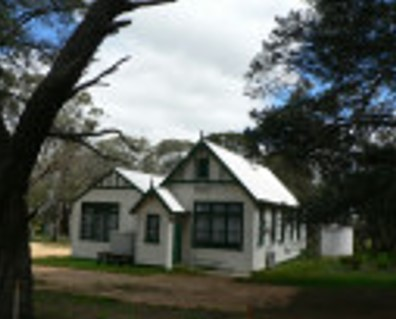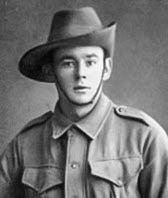James Alfred COZENS
Eyes grey, Hair auburn, Complexion sallow
A Search to Find James
Can you help us identify James?
James was killed in Action at Fromelles. As part of the 29th Battalion he was positioned near where the Germans collected soldiers who were later buried at Pheasant Wood. There is a chance he might be identified, but we need help. We are still searching for family contacts.
In 2008 a mass grave was found at Fromelles, a grave the Germans dug for 250 (Australian) bodies they recovered after the battle.
If you know anything of contacts here in Victoria, Australia or his ancestral Cozens connections from Wiltshire. Please contact the Fromelles Association.
See the DNA box at the end of the story for what we do know about his family.
We would like to thank Beth and Les Roberts, Doug Cozens and Geoffrey Cuckson for their efforts in James’ DNA search and their contributions to this story.
The Cozens from Western Victoria
James Alfred Cozens was the youngest of George and Susan Alice (nee Gangell) Cozens five children:
- William Henry 1886-1949 m Mabel Jessie Hughes, 1912
- Elizabeth Matilda 1889-1964, m William Henry Connell, 2 sons.
- David Wesley 1890-1947 m. Eleanor May Trotter 1914, 2 sons, one daughter
- Jane Beatrice 1892-1978 never married
- James Alfred 1897-1916
George’s father had come from Wiltshire, England and his mother was from Tasmania. Susan’s father was born in Tasmania. James’ parents were married in 1885. James was born in May 1897 in Horsham, northwest Victoria. He attended the Berringa State School, where his father was working as a gold miner from around 1905 to 1912.
In 1913 they had moved to Richmond, an inner Melbourne suburb. After he completed his studies, James became a pastry cook.
A Youngster Off to War
James felt the Call to War, but as he was 18, he needed parental approval, which was readily given.

He was assigned to A Company 29th Battalion, which had just been raised at Broadmeadows Camp in Victoria on 10 August 1915. James had settled in with his new mates and, being 5’10” (very tall for the time), they gave him the nickname “Long-un”.
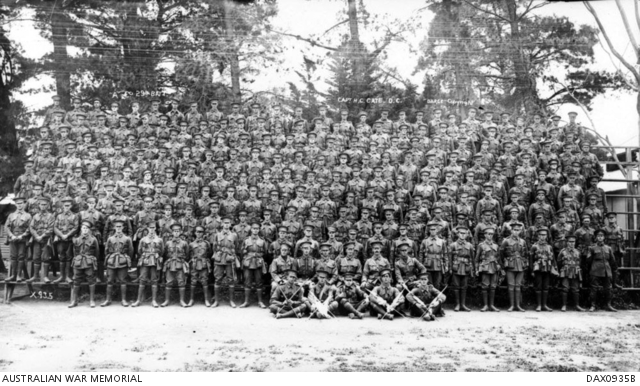
After a short period of military training, the 29th left Australia on 10 November 1915 headed for Egypt aboard HMAT A11 Ascanius. Before departing, the soldiers had been on parade in Melbourne in front of a good crowd and were reviewed by the Minister for Defence, H.F. Pearce who said:
“I do not think I have ever seen a finer body of men.”
After a month’s voyage, James arrived in Suez, Egypt. Their training and defence of the Suez Canal continued until mid-June with postings at Ismailia, Tel el Kebir, Ferry Post and Moascar. The troops were reviewed by the Prince of Wales while in Tel el Kebir.
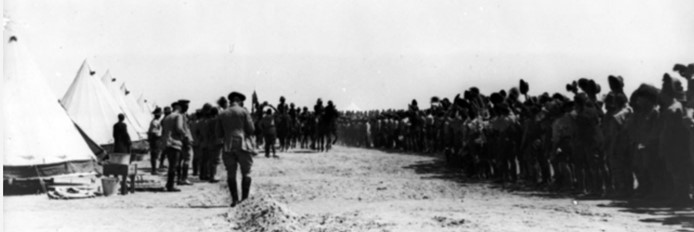
The Western Front and Fromelles
The call to the Western front came and on 16 June, the 29th boarded the troop ship Tunisian in Alexandria, headed to Marseilles, arriving there on the 23rd. They then were on a train to Hazebrouck then to Steenbeque and by the 26th were encamped in Morbecque, about 30 km from Fleurbaix. The Aussies were well received by the French. In a letter home, James Lang (858), 29th Battalion from Glengarry, Victoria, wrote:
“The French people lined the streets to see us, and gave us a great welcome. Lots of poor women and young girls started crying. No doubt the poor things were thinking of their own dear ones who had gone to the front.”
On 1 July the 29th moved back to Hazebrouck. Gas masks were included in their training for the possible use of “lachrymatory shells” – tear gas. Training was tough and rugged. One day included a march of 16 miles carrying a 75 lb. kit, which only the youngest and fittest could complete. On the 9th July they were moved to Erquingham, just outside of Fleurbaix and on the 10th they got their first experience in the trenches with the “men all in good spirits”.
Source AWM4 23/46/12 29th Infantry Battalion July 1916 page 3
They were back at their billets in Fleurbaix four days later. A gas alarm was sounded on the 15th, but there was no effect on the troops in Fleurbaix.
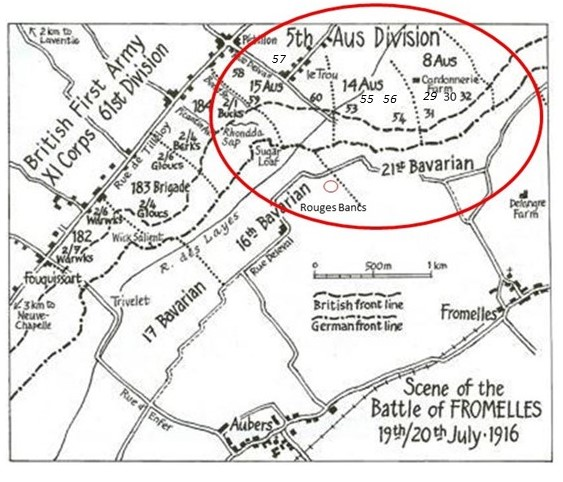
The 29th’s role was to be a ‘fourth’ battalion on the left flank of the attack. With the 30th they were to provide support for the attacking 31st and 32nd Battalions by digging trenches, carrying supplies/ammunition and to be called in as reserves if needed for the fighting. The original attack was planned for the 17th, but bad weather caused it to be postponed.
On the 19th July the 29th were in the rear trenches, ready for the attack. The 32nd’s charge over the parapet began at 5.53 PM and the 31st’s at 5.58 PM. There were machine guns emplacements to their left and directly ahead at Delrangre Farm and there was heavy artillery fire in No-Man’s-Land. The initial assaults were successful and by 6.30 PM the Aussies were in control of the German’s 1st line system, which was described as “practically a ditch with from 1 to 2 feet of mud and slush at the bottom”
Source AWM4 23/49/12, 32nd Battalion War Diaries, July 1916, page 11
By 8.00 PM, James’ A Company and D Company began to carry bombs and supplies to the front trenches. The Australians’ left flank had also come under heavy bombardment with high explosives and shrapnel. Return bombardment support was provided and the 32nd was told “the trenches were to be held at all costs”.
Source AWM4 23/49/12, 32nd Battalion War Diaries, July 1916, page 12
At 10.00 PM, additional support was being requested and C and D Companies joined in. Unfortunately, they found that a number of the grenades they were carrying had no fuses. The Germans counterattacked and at 2.00 AM James’ A Company was drawn directly into the fighting. B and C Companies were also engaged, continuing to carry supplies and providing cover for soldiers who were retiring from the battle. However, “After a struggle in No-Man’s Land, the Germans were content to stop at their own trench.”
Source AWM4 23/46/12, 29th Battalion War Diaries, July 1916, page 7
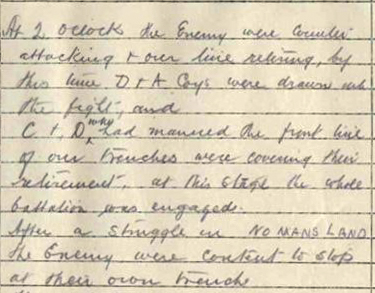
At 2 O’clock the enemy were counter attacking….
Fighting continued through the night. At 4.00 AM the Germans began an attack from the Australian’s left flank, bombing and advancing into the communications trench. Given the Australian advances that had been made earlier, portions of the rearward trench had been left almost empty, which then enabled the Germans to be in a position to surround the advanced soldiers. Based on Red Cross witness statements, it is likely that James was killed during their retreat.
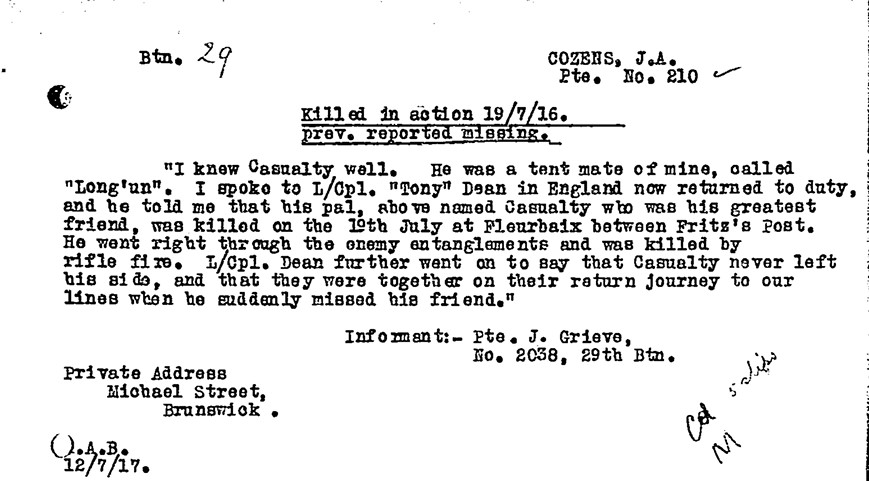
Private F.J. BRYANT (183) added:
“… the 8th Brigade advanced to the German 1st and 2nd lines and held the position for 11 hours, when what was left of the Brigade was ordered to retire. Six men were returning to the original line of whom Cozens was one, but he fell, badly wounded in the back and other places, between the 1st and second German lines.” “…it was impossible to render assistance.”
Ultimately, for a Battalion in ’reserve’, 66 soldiers of the 29th were killed in action or died of wounds from the battle and 37 of them were unable to be identified.
After the Battle
With all the chaos from the battle, it took until the end of August for James’ family to be notified that he was missing in action, but that was all the information that the Army had available. Following searches for witnesses, prisoner of war details, etc, on 18 April 1917 James was formally declared as having been killed in action on 19 July 1916 (though his witness statements would suggest it was the morning of the 20th). The Germans did recover James’ body after the battle - he was on a ‘German Death List’ dated 4 November 1916.
His ID disc was returned to the family in late 1917. Curiously, there is a handwritten record in his file of being ‘buried at Fleurbaix’, with a generic map reference, but this is also in many other missing soldiers’ files.

James was awarded the 1914-15 Star Medal, the British War Medal, the Victory Medal and a Memorial Plaque and a Memorial Scroll. James is commemorated at V.C. Corner (Panel No 1), Australian Cemetery Memorial, Fromelles, France.
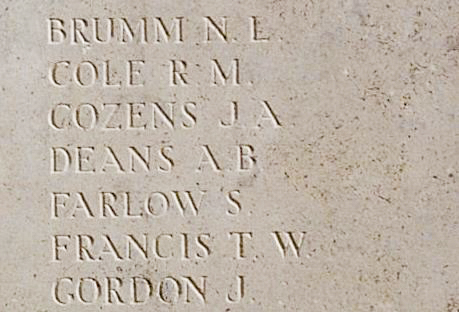
The Search to Find James
When the mass grave at Pheasant Wood was discovered, given James’ position in the battle and knowing his body was recovered by the Germans, he was identified as being a candidate to have been buried in the grave. Family member DNA was then needed to find out and the search to find them was on. The family in Western Victoria knew little of James, as his branch of the family moved to Melbourne from Horsham before WWI and contact was lost. It was only when news of Pheasant Wood became more widely known that the present-day family discovered his existence and they embraced the task of finding James.
DNA matching is complicated by the need to have male and female donors that have a direct male to male to male and female to female to female ties. Both Doug Cozens and Beth Roberts and her husband Les took up the challenge to find the donors. James was a first cousin of Doug and Beth’s father Read Cozens, making Doug and Beth first cousins, once removed. James’ brother David had a son, Arthur. To the best of Arthur’s recollection, little was spoken of James after his death, but he did have a photo of James in uniform and his Memorial Plaque.
Even at 90 years old in 2011, he was more than pleased to have donated DNA. James’ aunt had a daughter and Beth and Les were able to follow that female line to a current descendant and obtain a DNA sample. Beth’s brother Douglas also gave a sample. Unfortunately, there was no match from these samples, much to everyone’s disappointment. The family however, remains hopeful that one day James will be identified and receive the named headstone which he so richly deserves.
Seeking James - a Double Connection for the Families of Cozens and Cuckson
When Melbourne amateur historian Lambis Englezos led investigations and advocacy to find and recover many ‘Lost Diggers of Fromelles’ with his friends, he could not have imagined how many diverse and far-reaching connections his actions would lead to. As well as James, Private William Joseph Cuckson (3032), 54th Battalion from Sydney was also on the German Death List:
“One Hundred Years apart.
Almost forty years ago, two young families, unknown to each other, and from separate parts of Victoria, moved to settle in the Western District town of Hawkesdale, a small rural community some 40 km north of the coastal city of Warrnambool.
Having young children of their own, sheep farmers Doug and Rosalie Cozens, and Post Office operators Geoff and Sue Cuckson became good friends and involved themselves in the many activities within that close knit community.
With two young lads each at the time, the Scout Group beckoned for Doug and Geoff to take on leadership roles within the local movement. Many a cold sleepless night was spent overseeing troop camp outs and the men revelled in their involvement with, and leadership of, active teenage lads.
As it does, time marched on and some eight years later the families went separate ways - Cuckson and his family relocating to Gippsland whilst Cozens remained local on his well-cared for sheep farm.
Although they retained contact from afar, little did the men know that their close connection would resurface three decades later from the other side of the world.
Geoffrey’s grandfather’s brother, William Joseph Cuckson, is one of the initial 75 soldiers at Pheasant Wood who were identified in 2010. Unfortunately, James Cozens remains unidentified.”
Tying the Cozens and Cuckson families together, Geoffrey Cuckson said he has had an unbelievable and somewhat emotional journey to find and identify his great uncle William Cuckson and to attend the centenary service at Fromelles in July 2016.
His one burning wish now is that he can once more stand beside his friend Doug Cozens and celebrate the dedication of a newly named headstone for another brave lad from that conflict – #210 Private James Alfred Cozens.
Beth’s family provided the content for an entry on James in a book written by the Horsham Historical Society on local involvement in World War 1.
100th Anniversary of Fromelles commemoration at Pheasant Wood:
“Beth and I attended the 100th anniversary of Fromelles in 2016. We selected a grave of an unknown Australian soldier next to the grave of an identified soldier from the same battalion and who came from Nhill, near Horsham in the Wimmera in Victoria.
The unknown soldier’s grave became James for the day and we paid appropriate marks of respect. Unfortunately, Beth’s brother Douglas and his wife Rosalie were unable to be there and thus missed seeing Geoff Cuckson.
We also visited the memorial and cemetery at VC Corner, where James’ name is recorded and there paid appropriate marks of respect, as we had done on a previous visit in 2011.
We also met Geoff Cuckson and his family after the ceremony and spent quite some time talking, before we had to go our separate ways.
It is good to see the effort being put into ensuring that the men who were forgotten for so long are now being remembered. Please keep up the good work.
Kind Regards, Les Roberts”
To date (2024), 22 of the 37 unidentified soldiers from the 29th Battalion have been found to be at the Pheasant Wood burial site and 70 out of the 250 soldiers from the grave remain unidentified. There may still be hope to find James. We are seeking further family contacts.
Lest we forget.
DNA samples are being sought for family connections to
| Soldier | James Alfred COZENS (1897-1916) | Missing at Fromelles |
| Parents | George Cozens (1860-1922) Woodford Vic and Sue Gangell(1865-1921) Victoria. |
| Siblings | William Henry (1886-1949) m Mabel Jessie Hughes, 1912 | ||
| Elizabeth Matilda (1889-1964) married William Henry Connell 2 boys | |||
| David Wesley (1890-1947) m. Eleanor May Trotter 1914, 2 sons, one daughter | |||
| Jane/Jean Beatrice (1892-1978) never married |
| Grandparents | |||
| Paternal | William Cozens (1830-1898) Hardenhuish, Wiltshire and Catherine Taylor (1840-1929 Died) Tasmania | ||
| Maternal | David Gangell (1839 – 1877) Carchap, Vic and Matilda Roberts (1846-1914) Bilinee, Vic |
The Fromelles Association would love to hear from you

Contacts
(Contact: carla@fromelles.info or geoffrey@fromelles.info).
(Contact: army.uwc@defence.gov.au or phone 1800 019 090).
Donations
If you are able, please contribute to the upkeep of this resource.
(Contact: bill@fromelles.info ).

